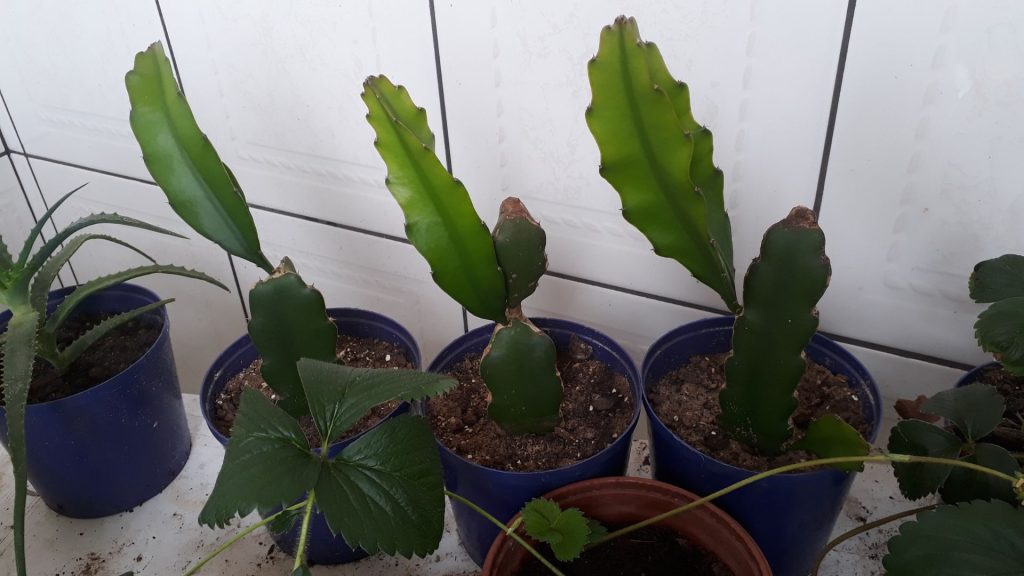Today, more and more gardeners, both experienced and novice, want to grow dragon fruit right at home. It is an exotic fruit with a bizarre shape, and a taste reminiscent of kiwi. Perhaps you managed to see the dragon fruit cactus from your neighbors or acquaintances as a houseplant. Let’s find out more about it.
Dragon fruit is a cactus that differs from other inhabitants of the dry and hot equatorial climate. The plant can develop normally even without an abundance of sun. True, for fruiting, it still needs light. Often this fruit is grown in voluminous pots, carried out in a shady garden for the summer. Its fruits are covered with large smooth outgrowths or scales. Depending on the type, the peel can be colored in a mixture of pink and salad colors. Cactus fruits are oblong, not larger than an apple. Under the peel, they have white, red, or dark purple flesh, dotted with small black seeds.
Please note that with the indoor growing of dragon fruit, flowering and fruiting of a cactus can sometimes begin only after 5-7 years.
Species of Dragon Fruit Plants
Among all the varieties, dragon fruit became famous mainly for its three representatives, which are the most popular and delicious:
- White (Hylocereus undatus) is the most exotic and popular variety, it has pink-red scaly skin on the outside, and on the inside is soft and delicate white flesh with a pleasant taste and aroma. Multiple black seeds.
- Red (Hylocereus costaricensis) has bright pink-red skin and a creamy red pulp with an even more intense taste. Small black seeds, like in kiwi.
- Yellow (Hylocereus megalanthus) looks like a bright yellow lemon in large pimples. Inside it is snow-white with multiple black seeds. It is considered the most aromatic and sweet.
How Big Do Dragon Fruit Plants Get
A mature plant can reach 25 feet (7.62 m) and several hundred pounds.
What Climate Does Dragon Fruit Grow In
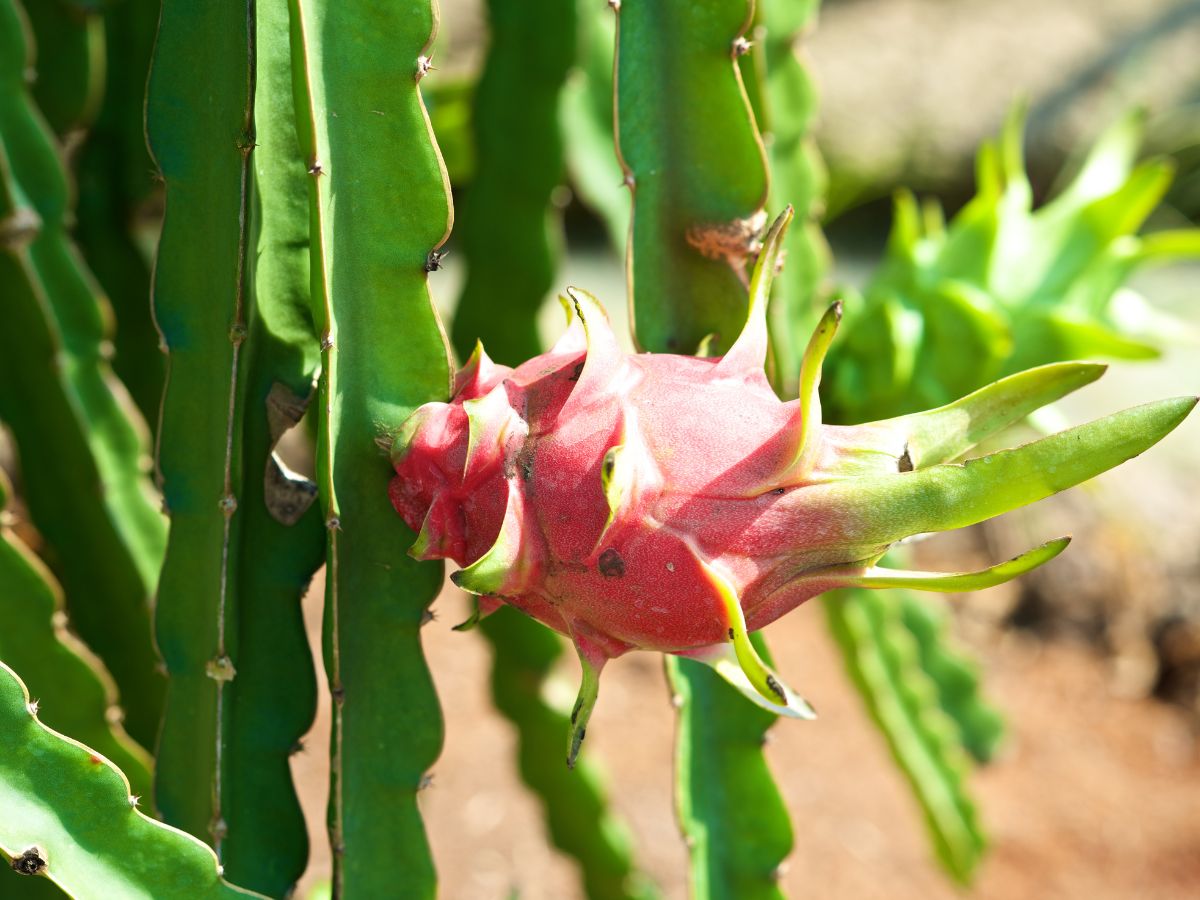
In nature, dragon fruit grows in the dry and hot climate of the tropics, and the closer to this the conditions of its keeping, the thicker and fleshy the stems would be.
Dragon Fruit Growing Zone
Dragon fruit can grow in the USDA zones 9 through 11, although the plant should be protected from frost in zone 9. Outdoor dragon fruit grows well in full sun or filtered sun in very hot places.
When Do Dragon Fruit Bloom
The pitaya plant growing in the jungle usually blooms from early summer to mid-autumn. The dragon fruit cactus is a plant that blooms at night and the flowers only last one evening.
Now that we have learned the basic information about this plant, let’s learn how to grow dragon fruit.
Dragon Fruit Plant Care
Lighting
Lighting for the plant is not key for the development of fruits – the combination of direct rays of the sun and partial shade would be optimal, this indicates that dragon fruit is an unpretentious culture.
Watering and Humidity
When watering dragon fruit, it is worth observing the regularity in the spring, as well as in the summer, rarely in the fall, and in winter you can limit it as much as possible.
The plant prefers an average room humidity level. It tolerates drying out of the soil well – in the spring it can stimulate flowering. Like other cacti, it is better not to water the plant at all than to water it over, because in this case, the plant may die.
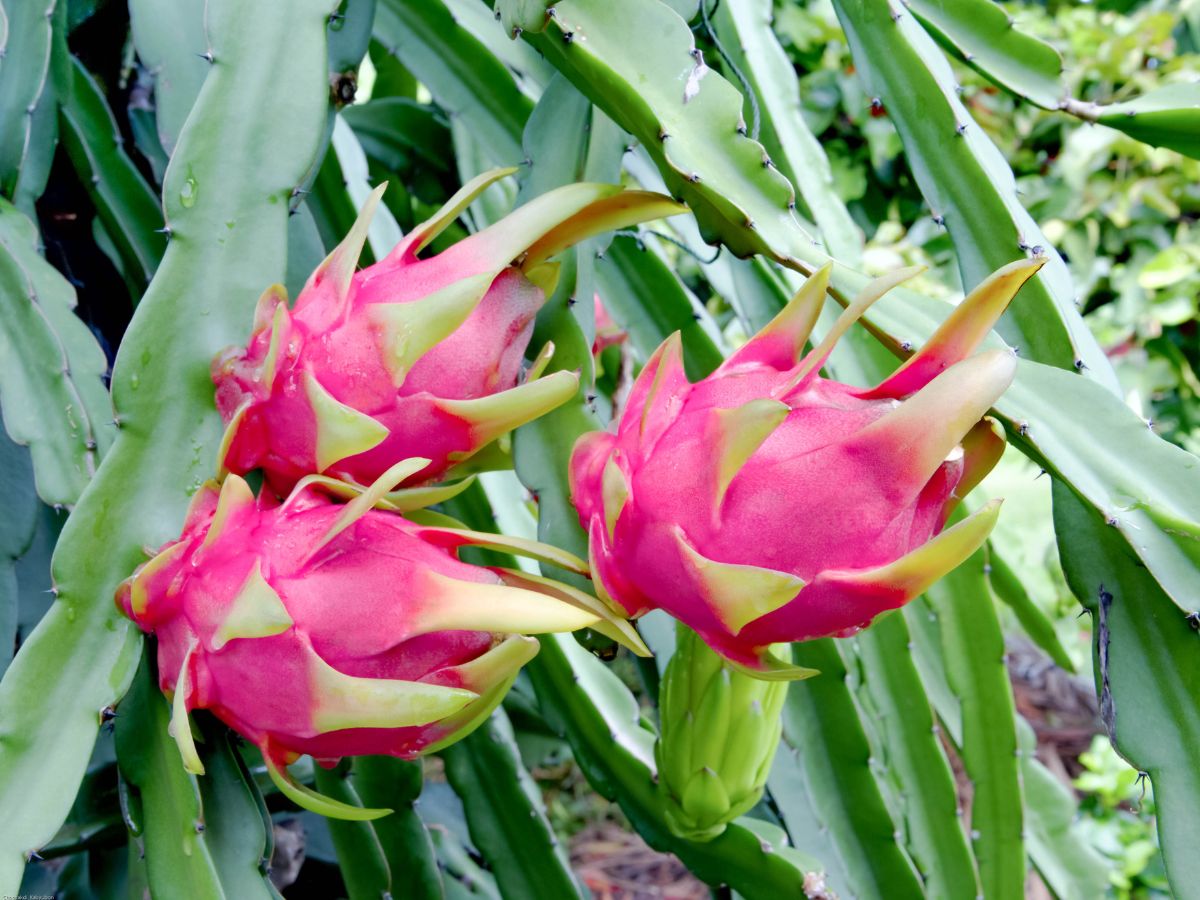
Top Dressing
Since this fruit is an unpretentious example of living nature, it grows well without additional feeding. You can add a little top dressing when watering in the spring and this may only have a positive effect on the growth, flowering, and development of the plant.
Dragon Fruit Fertilizer Requirements
Inorganic fertilizer formulations provide rapid release of essential plant nutrients such as nitrogen, phosphorus, and potassium. To create the best fertilizer for dragon fruit plants, we recommend combining them with the more complex nutrients found in organic fertilizers such as seasoned manure or compost.
Temperature
This plant loves warmth – the optimal temperature for dragon fruit should be about 25-28 °C, in winter the temperature regime can drop to 17 °C, although the plant can withstand even lower temperatures.
Plant Transplant
Transplanting dragon fruit should not be done more than once a year (or better still less often). When transplanting, you need to make sure that the soil is well-drained, and the substrate into which you are replanting is moist only in the upper part. It takes about 2-4 weeks for the dragon fruit to take roots. And for the plant to feel better, you can build a structure that can be a support for the plant.
How to Propagate Dragon Fruit
To grow dragon fruit in pots, you can propagate it using seeds or cuttings.
Growing Dragon Fruit Plant from Seeds
The fruit is grown at home from freshly harvested seeds, but dried seeds also retain the ability to germinate for some time. Pitaya pulp contains small seeds that are washed thoroughly before planting. For planting, you need the pulp taken from the ripe fruit, knead it thoroughly, fill it with water and let it stand for some time.
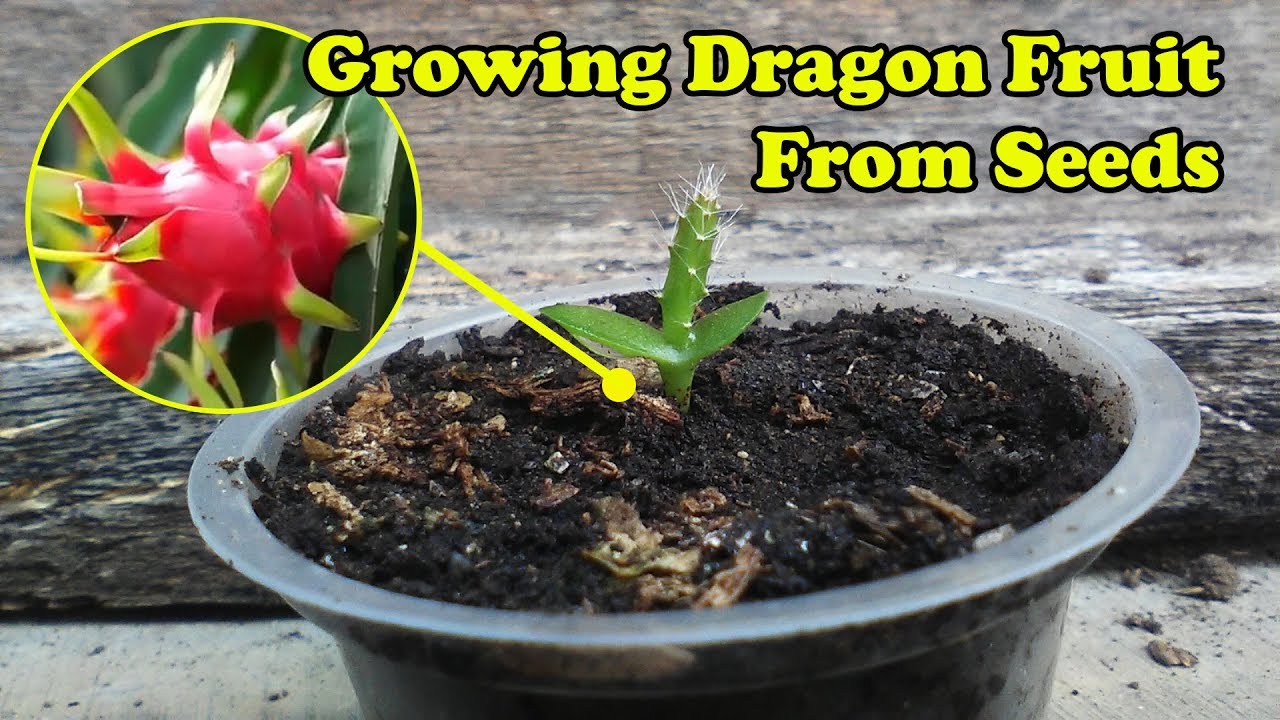
Then strain through sieves with very small meshes. This procedure should be repeated several times so that the seeds are completely free of pulp. If at least a little pulp remains on the seeds, later, after planting, they would not germinate, since the process of decay can begin. Then you need to dry well-washed dragon fruit seeds and after a few days to plant them in soil pretreated with bio fungicide to eliminate possible mold formation.
How to Plant Dragon Fruit
The pot size for dragon fruit must be at least 10 inches deep and 24 inches wide. It is better to choose the soil for dragon fruit that is intended for succulents (it can accumulate moisture). A pot with soil for a future plant must necessarily have a drainage layer at the bottom.
When sowing, the top layer of the soil is moistened, with the expectation that moisture would penetrate the soil no more than two-thirds in depth. After planting the seeds, the pot is covered with a transparent material (glass, plastic, polyethylene) to create greenhouse conditions.
The first dragon fruit sprouts appear after the first week and transplantable plants after 4 weeks. After that, young plants dive into separate pots for further growth and development. In the future, plants can be kept in a cool room with constant soil moisture.
How Long Does It Take to Grow Dragon Fruit from Seed?
In favorable conditions, pitaya grown at home from seed may be able to please you with huge fragrant flowers in a few months, but they bloom only one night. And with successful pollination, the formation of ovaries of future dragon fruits is quite realistic. The plant is unpretentious in care, so the vast majority of attempts to grow these cacti from seeds are successful.
Reproduction of pitaya can also be done by cuttings. This is an easier and faster way. But for it, you only need mature and healthy plants.
Propagation by Cuttings
You can also grow dragon fruit from cuttings rather than seeds if you want to save your time. We recommend that you get a large cutting from a professional nursery or from a friend who also successfully grows dragon fruit. Let’s find out how to plant dragon fruit cuttings.
To do this, you need to cut off the stalk from it, dry it for 2-5 days, and only then plant it in the substrate. For the cutting to take root well, it must be placed in a bright diffused light and kept at a temperature of 24 °C. Germination of cuttings, like dragon fruit seedlings obtained from seeds, is quite active. After 6-8 months, a full-fledged plant is obtained.
How Long Does It Take for Dragon Fruit to Grow
Plants can start flowering in as little as 6-8 months, although container-grown plants can take up to 2 years to bear fruit. But the good news is that when the dragon fruit is ripe, you can see four to six fruiting cycles per year.
How to Get Dragon Fruit to Flower
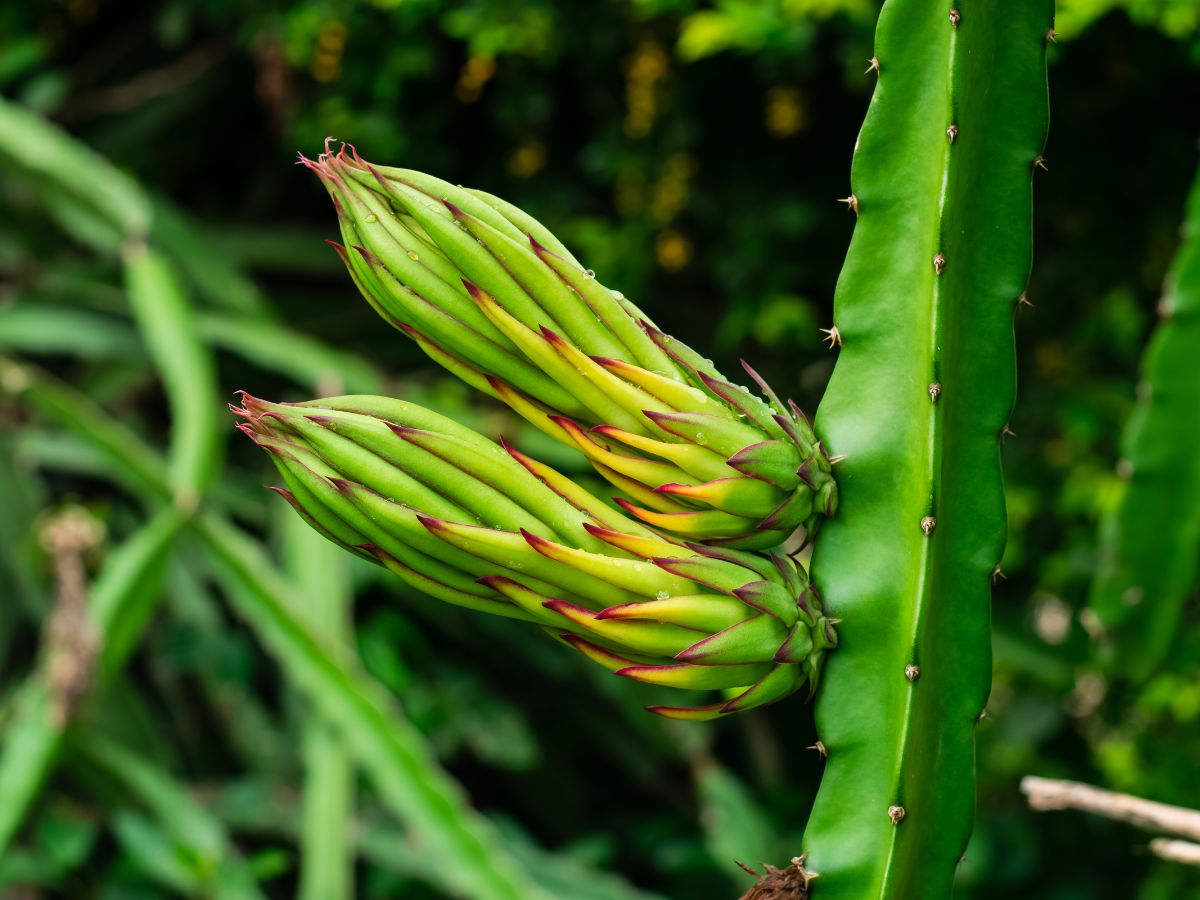
To stimulate pitaya cactus to set flower buds, in January the plant must be stopped watering and placed in cooler than usual conditions – with a temperature of 14 °C. After a month of such artificial wintering, flowering usually occurs after 6-10 weeks. For the flowers to produce fruits, the cactus needs pollination, which сan be done artificially. For this, you need to move pollen from the stamens to the pistils.
Possible Growing Problems
The biggest enemy of the plant is excess moisture, which can cause the appearance of fungi and bacteria, due to which the flowers begin to fall off early, unripe fruits rot and, as a result, the plant can die. The humidity level must be observed very strictly, and then the plant would bear fruit well and please you with its harvest.
Useful Properties of Dragon Fruit
The dragon fruit is a valuable dietary low-calorie product with a high content of nutrients. The main components of the pulp are carbohydrates and water; polyunsaturated fats are present in small amounts. It is a good source of antioxidants, vitamins B1, B2, B3, and especially vitamin C, calcium, phosphorus, iron, and other mineral components, as well as dietary fiber. The fruit is useful for diabetics and hypertensive patients, it lowers blood cholesterol levels, increases immunity, and improves the activity of the gastrointestinal tract.
How to Eat Fruit
Pitaya is most often eaten fresh. The fruit is cut with a knife along or across, then the halves are placed in the refrigerator to cool so that the fruit becomes more juicy and aromatic. Eat only the white pulp of the fruit, along with small black seeds. If you follow all the conditions for growing dragon fruit, then you would not have problems, since the plant is quite easy to care for.
Growing pitaya at home is an exciting process for every lover of exotic plants. If you have been thinking about growing this plant for a long time, then feel free to start! They are quite unpretentious, so you can easily cope with this task. And as a reward for your efforts, you can become the owner of a unique tropical plant and would be able to taste its fruits!


